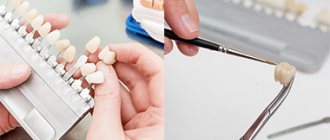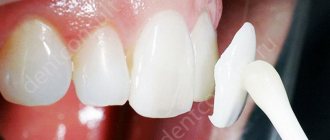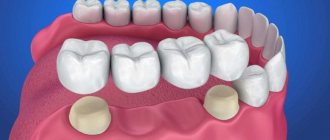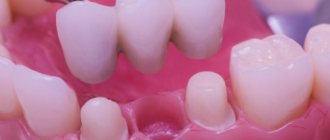Modern dentistry can offer different types of orthopedic structures, including metal-ceramic crowns, for successful reconstruction of lost teeth. We will discuss the features of metal-ceramic crowns in detail below: we will consider their structure, stages of production and installation, advantages and disadvantages, and the cost of metal-ceramic crowns for teeth.
Calculate the cost of treatment by taking a short test in 20 seconds!
Do not delay your treatment, because in this matter time plays against us.
General information and unique features
Metal-ceramic crowns are one of the most popular types of orthodontic structures among dental patients. The increased demand for this particular type of orthopedic products is explained by their durability, high aesthetics and impeccable positive results in the restoration of lost teeth. The price of metal-ceramic crowns is an order of magnitude higher than that of crowns made of metal alloys, but at the same time they are more affordable than designs made of expensive dental porcelain.
Metal-ceramic crowns have a special design: inside there is a strong frame base made of metal alloy, which is covered on the outside with a dental porcelain finish. The finish is applied to the frame base of the crown in layers: and each layer of applied material undergoes heat treatment in a specialized oven at elevated temperatures.
Layer-by-layer application and subsequent heat treatment provide super-strong adhesion between the metal base and the ceramic composition applied to it. Below we post a photo of a metal-ceramic crown; after studying it, you can see exactly what it looks like.
Further in the material, we will thoroughly understand the advantages and disadvantages of metal-ceramic crowns, and also find out why there is a fairly large price range in dental clinics for the cost of metal-ceramic crowns with work, and we will explain in detail why in this case the lowest price offer is not the most profitable, on the contrary, it can significantly increase costs.
The use of metal-ceramics in prosthetics on implants
Metal ceramics are an excellent option for use on implants. For example, it is impossible to install pure ceramics on metal roots, since they are much stronger than the material of the upper part, and under pressure the ceramics will simply fall apart. This will not happen with metal-ceramics - when fixed to implants, the internal metal base comes into contact with their top and this combination is extremely strong and durable. But external ceramics serve only to create aesthetics.
Points to consider
If you definitely decide to install a metal-ceramic crown, then you should definitely take into account that different types of metal-ceramic products differ not only in price, but also in service life, aesthetic indicators, reliability and strength characteristics. We will tell you more about the types of metal-ceramic crowns below, but for now we will make one more important note: when planning to install a metal-ceramic crown in dentistry, it is extremely important to choose the right clinic to receive this service. Even the most expensive and well-made metal-ceramic crown will not last long if:
- The dental units were poorly prepared and ground for the installation of a metal-ceramic crown;
- When taking impressions for its manufacture, the specialist made a mistake.
Preparatory procedures for installing a metal-ceramic crown always begin with sanitation of the oral cavity and treatment of all diseases of the teeth and oral cavity identified during the examination. If the root canals of the tooth are treated incorrectly, errors are made in their filling - in the future there is a high risk of an inflammatory process occurring in them. The occurrence of inflammation can lead to the fact that the prosthesis will have to be removed, treated, and then all restoration manipulations will have to be carried out from the very beginning.
To prevent such negative consequences, the doctor must refer you for a control X-ray examination after therapeutic and other manipulations: pulp removal, canal filling.
No less important are the quality of grinding teeth for crowns and the accuracy when taking impressions. If the doctor makes a mistake at this stage of treatment or uses an inexpensive material that cannot accurately convey all the individual characteristics of the teeth, the finished crown will not adhere to their surfaces with the required degree of density. Saliva will constantly flow under it, and pathogenic microorganisms will enter, provoking the development of caries and decay in dental tissues.
For these reasons, it is recommended that before starting treatment and installing metal-ceramic crowns, make sure that you turn to professionals. Dental prosthetic services of European quality level are provided in our dental clinic in Moscow - Vanstom. If you want to find out the cost of a metal-ceramic crown, get professional advice on prosthetics from an experienced and competent specialist - come to our Vanstom dentistry! We are located in the center of Moscow, our exact address: Moscow, Baumanskaya metro station, st. Bakuninskaya, 17/28.
Rules for wearing and care
How long it takes to get used to metal-ceramic crowns depends entirely on the skill of the implantologist, orthopedist and dental technician. An ideally made product should feel like “native” and not cause inconvenience, i.e. no need to get used to it. It’s another matter when there were no teeth for a long time, and now, after prosthetics, the tongue occupies a slightly different position. Therefore, a lot of saliva appears, and difficulty with diction arises. In this case, adaptation may take 1-4 weeks. And to speed up the process, practice more often - read books, poems, tongue twisters out loud.
How to care for metal-ceramic prosthetic structures? Caring for metal-ceramic crowns is not much different from caring for your own natural teeth. Here are some recommendations that should be followed to ensure that the restoration remains functional and aesthetic for a long time:
- Maintain oral hygiene: how to clean metal-ceramic crowns? Just like your natural teeth - twice a day with a brush and paste, using a rinse and irrigator. You can also use special dental floss “super-floss”, but it is better not to use toothpicks and chewing gum,
- exclude excessively hard and brightly colored products: in order not to break the prosthesis (and even the implant!) and prevent it from becoming irreversibly stained - after all, it is not possible to bleach the ceramics,
- Visit your dentist regularly to assess the condition of the restoration, as well as to have your new teeth cleaned and polished so they will retain their original shade longer.
Types of metal-ceramic crowns
In Moscow dentistry, metal-ceramic crowns for restoring lost or severely damaged teeth can be offered in three main types:
- Traditional crowns;
- Products from precious metal alloys;
- Crowns made using specialized milling equipment.
The price of metal-ceramic dental crowns will largely depend on their type, and therefore you should familiarize yourself with the features of each type in advance. Let's look at the characteristics of different types of metal-ceramic crowns below.
Alternative to crowns on front teeth -
There are 3 main alternatives to artificial crowns, which can be used when one or more teeth are missing and/or to restore the crowns of partially destroyed teeth.
- Veneers (Fig. 23-25) - if you have partially destroyed only the front surface of one of the front teeth, then the best option would be to make a veneer rather than a crown.
A prerequisite for veneer prosthetics is the preservation of the lingual wall of the tooth. Veneers allow not only to preserve the maximum volume of tooth tissue, thereby increasing its service life, but also to achieve very good aesthetics. Prosthetics of front teeth with veneers: before and after photos
- Implants - if 1-2 teeth are missing, restoration of missing teeth is usually carried out using bridges, while the teeth on the sides of the dentition defect are ground down into crowns. On average, the lifespan of well-made crowns is only about 10 years, so the best solution in this situation is to install dental implants instead of grinding down the teeth for crowns.
- Restoration – restoration of a partially destroyed tooth using filling materials is called dental restoration.
There is a rule in dentistry: if the crown of a tooth is destroyed by less than 1/2, this is an indication for restoring the tooth with filling material. However, if the tooth is destroyed by 1/2 or more, this is an indication for restoring the tooth with a crown. Of course, you can try to restore even a badly damaged tooth, from which almost only one root remains, using filling material. However, such tooth restoration will inevitably end with a root fracture sooner or later, because designs made of pins and filling materials are not designed to bear heavy chewing loads. We hope that our article on the topic: What are the best crowns for the front teeth, price – was useful to you!
Sources:
1. Personal experience as a dentist, 2. “Orthopedic dentistry. Textbook" (Trezubov V.N.), 3. American Academy of Cosmetic Dentistry USA), 4. National Library of Medicine (USA), 5. "Orthopedic treatment with fixed dentures" (Rozenstiel S.F.), 6. https: //www.realself.com/.
Traditional metal-ceramic crowns
For classic metal-ceramic crowns, prices in Moscow are offered at relatively affordable prices, since alloys from available metals - cobalt, chromium - are used to create the frame base. The frame part turns out to be quite strong, but there is one significant nuance: it is not completely processed with ceramic mass; without a layer of ceramics, a small ledge remains in the area of contact of the prosthesis with the gum. This entails contact of the metal surface with soft tissues, which is why the gums take on a distinct, unsightly bluish tint.
You can avoid this negative phenomenon by ordering the production of a metal-ceramic crown with shoulder mass. In this type of crown, the ledge is also covered with ceramic, like the rest of the frame, but its production will cost more.
Material
Different materials are used for the frame:
- Metal alloys
(chromium-nickel, cobalt-chromium) - such prosthetics combine efficiency, strength, and wear resistance. But the presence of nickel, chromium or cobalt in the structure increases the risk of developing allergies and contributes to the appearance of a bluish stripe at the border of the prosthesis with the gum, due to metal oxidation. - Alloys of noble metals
(platinum, gold, palladium) - allow you to make an aesthetic prosthesis of precise anatomical shape, do not oxidize, and do not cause allergic reactions. - Titanium
- structures made from this material are distinguished by precise edge fit, are completely biocompatible, and do not react to thermal or chemical influences.
The type of metal used as a base affects the performance of the orthopedic system. If there are doubts regarding the material of the prosthetics, at the RUTT clinic you can take a small sample of the metal for an allergy test. When installed on implants, the prosthesis is made of titanium of the same grade as the implant system.
Crowns with a frame base made of precious metals
The frame part of a metal-ceramic crown may be made from alloys of precious metals. The cost of a metal-ceramic crown in Moscow in this version will depend on the weight of the precious metal, as well as on its type and, naturally, will be higher than the price of a product with a cobalt-chrome frame. The advantage of this type of crown is their increased strength and more aesthetic appearance.
Crowns using computer technology
When producing a metal-ceramic crown of this type, its frame part is not cast from molten metal, but is produced on specialized milling equipment using an innovative CAD/CAM program. The use of this technology in the production of crowns makes it possible to produce a prosthesis that is ideally suited for a specific clinical case and has the highest possible degree of adherence to the dental surfaces, and this has a positive effect on both the strength of the crown itself and the aesthetics of the restoration as a whole.
For such metal-ceramic crowns and teeth, the price in Moscow starts from 20,000 rubles. What will determine the price of a metal-ceramic crown, what factors are involved and whether it is worth saving on the service by choosing cheap products - we will look at these pressing issues in detail in the next section of the article.
Cobalt-chrome crowns
Making a metal-ceramic crown from a cobalt-chrome alloy will be cheaper than making an analogue from precious metal or with a milled frame. If high-quality materials from German manufacturers are used for production, the average cost of a crown can be from 11,500 rubles. This price is relevant for prostheses without shoulder mass; products with this element will cost more - from 15,000 rubles.
However, you can see advertisements in which the price of a crown is much lower - from 5,000 rubles. You should not be tempted by the cheapness of the service, since the production of such inexpensive crowns uses low-quality materials and therefore the savings in fact are very doubtful. A frame made from cheap materials can break, and the ceramic layer can constantly chip off.
Crowns made of an alloy of gold and platinum (palladium)
Reviews about metal-ceramic crowns are mostly positive, but the production of such a prosthesis will cost you no less than 15,950 rubles. This figure will take into account not only the basic materials, but also the price of gold and other precious metals that will be used to obtain the alloy for the production of the crown base.
It will cost you the most to make crowns using the CAD/CAM system, but their high price is fully justified by the long service life of metal-ceramic crowns and high aesthetic performance. However, the final price of the crown may also include additional costs, including:
- 1. Production of temporary crowns from plastic and other types of polymers. It is impossible to do without the production of a temporary prosthesis made of plastic if the restoration is performed in the smile area.
- 2. Installation of a turnkey metal-ceramic crown involves preliminary treatment of the teeth, which is calculated separately and included in the final cost of the service.
Prices for metal-ceramic crowns seem high, but they are an order of magnitude lower than the cost of reconstruction with metal-free ceramic products and veneers. Moreover, the cost of the procedure will be paid off by the high quality and durability of the restoration result. How to choose the best metal-ceramic crowns without making a mistake with either price or quality - you can always ask Vanstom specialists this question! To make an initial appointment, just dial our contact phone number! Or come to our clinic at the address: Moscow, Baumanskaya metro station, st. Bakuninskaya, 17/28.
Indications and contraindications
This type of prosthetics is indicated in the following cases:
- with a significantly damaged tooth that cannot be filled,
- when there are prostheses that the patient does not like from an aesthetic point of view,
- when using bridges under supporting elements,
- with abnormally shaped teeth
- when there are non-carious dental diseases,
- when tooth color changes, in cases where whitening is useless,
- with increased tooth wear.
Contraindications:
- mobility of teeth 2 or 3 degrees, presence of periodontal diseases,
- the presence of a deep bite,
- thin walls of a tooth with a large pulp chamber or small teeth,
- bruxism,
- childhood or adolescence.
Review of advantages and disadvantages
Metal-ceramic crowns have both advantages and disadvantages, which you should familiarize yourself with as carefully and in detail as possible in order to make the right decision for yourself. Let's start with a quick overview of the pros.
- High-quality made and installed metal-ceramic crowns are distinguished by solid strength and durability. Their average service life is up to 15 years and at the same time they do not lose either their useful functionality or aesthetics.
- It is almost impossible to visually distinguish the finishing coating of crowns from natural teeth, which makes it possible to install metal-ceramic crowns on the front teeth included in the smile zone.
- When making a prosthesis, they can make you a metal-ceramic crown of the required color shade, which will match the tone of the natural enamel coating.
The outer ceramic layer of the prosthesis has a smooth and pore-free surface, and thanks to this, pathogenic microorganisms do not accumulate on its surface and deposits do not form. Crowns are quite easy to care for and, of course, among the advantages of the products it is worth mentioning the optimal balance between their cost and quality.
However, it is worth considering that metal-ceramic crowns also have disadvantages, to which experts include the following important features:
1. Metal-ceramic crowns cannot be used if a person has an allergic reaction to metals and their alloys. Moreover, if a person already has metal dentures in the oral cavity, then installing a crown made of a different alloy can provoke a galvanic effect - a phenomenon that causes an unpleasant metallic taste in the mouth, and also provokes a number of soft tissue diseases.
2. When installed on the front teeth, a metal-ceramic crown may not provide the required aesthetics, which is especially important if a person has naturally thin and transparent enamel. The restored unit will stand out noticeably against the natural teeth. Therefore, when carrying out restorative manipulations in the smile area, dentists advise using other types of orthopedic products - for example, metal-free crowns. If you need to restore chewing teeth, then metal-ceramics will be one of the best options, even if the crown is made without a shoulder element.
3. Possible change in the color of soft tissues and the appearance of a dark stripe at the edge of the prosthesis. These problems arise if standard metal-ceramic crowns without shoulder mass are chosen for reconstruction. The gum acquires a bluish tint due to the fact that the edge of the installed crown, which is not covered with a layer of ceramics, is closely adjacent to it. This is especially critical if restorative procedures are carried out in the frontal area and where the gums are clearly visible when smiling.
The appearance of a dark line in the restoration area is explained by the gradual descent of the gums downwards, as a result of which the metal not covered with ceramics will be visible. If you want to avoid such problems, you should initially order crowns with a shoulder element. They are more expensive than standard options, but at the same time they do not have areas without a ceramic coating and therefore their aesthetic indicator is much higher.
Dentists recognize that a significant disadvantage of metal-ceramic crowns is the need for grinding of teeth, during which a fairly large amount of natural tissue is ground off from the tooth. Teeth are treated over their entire surface, from the inside and outside, and the tissue is removed to a depth of two millimeters. Removing such a significant amount of natural tissue negatively affects the health of the tooth, making it more fragile and vulnerable to the action of harmful bacteria.
One of the disadvantages of metal-ceramic crowns is definitely the need that arises in some circumstances for preliminary depulpation of the tooth. This decision is made by the doctor in cases where the volume of tissue removed during grinding will be maximum: when a significant amount of dentin is removed, the risks of pulp burns and nerve death during further manipulations increase significantly.
Usually, teeth located in the smile zone are depulped, since they have less dentin thickness, but chewing teeth are preferably not depulped and left with a living nerve. You can get detailed advice about all the features of metal-ceramic crowns at an appointment with a specialist from our dentistry in Moscow - Vanstom!
Why do we need to change?
There are a number of reasons for this:
- Over time, the product loses its color and shape, especially when a low-quality prosthesis is installed or when the technological process of prosthetics is violated. The materials from which they are made absorb coloring substances contained in food and drinks. This causes darkening and highlighting of the dentition;
- individual intolerance to the composition from which the crown/bridge is made;
- inflammation of the gums, constant feeling of discomfort. The condition of the tissue around the supporting tooth directly affects the durability of the structure itself, which often leads to its loosening. Symptoms such as the appearance of blood during cleaning, swelling and redness should not be ignored. It is important to immediately make an appointment with a doctor and begin treatment;
- the support that is necessary for installing the orthopedic product is destroyed. As a rule, this is associated with the manifestation of caries, due to which the remaining part of the tooth dies over time, and the strength of the fixation is impaired;
- Some people experience changes in bone tissue, which leads to visible changes in the proportionality and structure of the jaw. This is because bridges cannot stop bone atrophy, in which the gums and jaw become smaller over time. And if the orthopedic design no longer matches the gums and jaw, then its stability is lost and the need for correction or replacement arises.
The main stages of dental prosthetics with metal-ceramic crowns
Reconstruction of lost or severely damaged teeth with metal-ceramic crowns is relatively quick. Even taking into account preliminary therapy and high-quality sanitation of the oral cavity, the installation of turnkey crowns will take no more than 2 weeks. Attention! If the clinic promises to make crowns in less time, then this is a serious reason to be wary, since a high-quality prosthesis cannot be made in a couple of days.
Restorative procedures involving the installation of metal-ceramic crowns are divided into the following stages
Preparatory stage.
The patient comes to the clinic and undergoes an examination in the dentist's office. An X-ray examination is required, which can show whether there is inflammation in the area of the tooth, which will later be restored with a metal-ceramic crown. If symptoms of inflammation are present, then you will need to treat the tooth by carefully treating and filling the canals. If the tooth canals have been treated previously, then the quality of their filling will certainly be checked.
If the examination reveals that the patient has caries or other dental diseases, worn out old fillings, all this must be eliminated before the teeth are turned and prepared for a metal crown. The installation of a metal crown does not always require preparation (removal of the pulp and nerve), mainly in cases of restoration of anterior teeth and with one root, but dentists prefer not to subject chewing teeth to this procedure without clear indications.
A tooth in which more than 50% of the crown is destroyed is restored: for this, a pin is screwed into the canal, after which the coronal part of the unit is built up with a filling composite. Installing a pin allows you to give the filling the required degree of strength necessary for the restored crown to be able to withstand the stress of chewing food.
But there are cases when the tooth is left with extremely thin walls, or even just one root. In this case, before restoring the unit with a metal-ceramic crown, a special inlay is installed in the tooth. The metal-ceramic crown is firmly fixed to it, and the inlay helps protect the prosthesis from breaking under load.
Prosthetics stage
After all the preparatory procedures are completed, teeth grinding begins. The unit on which the crown will be installed is ground on all sides to the thickness of the future prosthesis. After this is done, an impression is taken from the teeth, which is sent to the laboratory, where a dental technician will use it to make a metal-ceramic crown.
While the metal-ceramic crown is being made, the patient is offered a temporary prosthesis. Plastic structures are especially relevant for prosthetics in the smile area - they will help maintain its aesthetics. In addition, the temporary crown will protect the ground teeth from the negative effects of external factors.
An important point: it is worth knowing that the cost of preparing each tooth for installation of a prosthesis can range from 4,000 to 10,000 rubles, and therefore sometimes it may be more profitable to install a metal-ceramic crown on an implant. This is especially true for cases where only one tooth needs to be restored. In such circumstances, a metal-ceramic crown on an implant will not only reduce the cost of prosthetics, but also will not require grinding of adjacent supporting and healthy teeth.
Which is better: zirconium or metal-ceramic crowns?
The question of which crowns are better—metal-ceramic or zirconium dioxide—patients often ask dentists during consultations on prosthetics. This question can be answered this way: in terms of aesthetics, zirconium dentures are better than metal-ceramic crowns. However, if your natural enamel has a high degree of transparency, zirconium will not be the best material for the production of a prosthesis.
The zirconium dioxide frame is bright white and lacks transparency, and therefore the finished crowns will look unnatural against the background of other teeth in the row. If the enamel is highly transparent, it is best to give preference to crowns made from a separate type of dental porcelain - lithium disilicate.
If teeth restoration needs to be carried out in the area of chewing units, then zirconium crowns will be a good option, but there is one caveat - possible frequent chipping of the ceramic layer from the base of the frame. It is especially not recommended to install zirconium crowns on chewing teeth with an abnormal bite. In case of bite defects, the solution may be to install either metal-ceramic crowns or zirconium prostheses, but without applying layers of porcelain.
For prosthetics on the lateral chewing units, which experience maximum load when eating and chewing food, the best option may be duceram metal-ceramic crowns, produced by a German dental brand. The design of metal-ceramic crowns of this brand is unique - the proportion of ceramics in it is several times higher than the metal content and this not only has a positive effect on the strength of the prosthesis as a whole, but also significantly improves the aesthetics of the finished crowns.
Installing duceram metal-ceramic crowns will not be cheap - about 10,000 rubles per tooth, but the cost of prosthetics with this type of structure will be fully compensated by their durability and high quality. This type of metal-ceramic crowns cannot be recommended for prosthetics in the area of the front teeth; the difference between the prosthesis and natural teeth may be noticeable.
What specific type of crowns for prosthetics will be optimal in your case - this question is best discussed with the specialists of our dentistry in Moscow - Vanstom! To make an appointment at our clinic, just dial the contact phone number!
Calculate the cost of treatment by taking a short test in 20 seconds!
Do not delay your treatment, because in this matter time plays against us.
What are the alternatives?
As already noted, cermets can be replaced with products made from zirconium dioxide. Moreover, it can be used as “pure”, i.e. without facing, or facing with ceramic mass, and then firing. This is necessary if very white zirconium dioxide with minimal transparency is used - then the zirconium cap, after applying several layers of ceramics, will be indistinguishable from natural teeth and will last more than 20 years.
If the patient needs an extended bridge, then zirconium dioxide will make the restoration very expensive. In this situation, you can pay attention to cheaper, but lightweight and high-quality materials, for example, ceramic composite.
Service life of crowns, reviews
If you look for information about metal-ceramic crowns on websites on the Internet, you may notice that people often write negative reviews about this type of orthodontic products. But it is not the designs themselves that are to blame for this, but the poor quality of their manufacture, the incorrect preparation of the process of preparing for prosthetics with metal-ceramic crowns and its main stages. Below we will consider all the problems that may arise due to low quality of service.
1. Low aesthetics. After installing the crown in place, many people begin to complain that it stands out noticeably against the background of natural teeth. To prevent this from happening to you, the aesthetics of the crown must be assessed at the stage of trying it on, and if you are not satisfied with something, do not remain silent, but directly voice your complaints to the specialist leading your treatment.
2. Discomfort in everyday use. It can also be detected at the fitting stage. The crown may not fit tightly onto the prepared unit, or the patient will notice that he cannot close his jaw normally because the denture is too high. Such defects indicate that an impression was taken incorrectly and inaccurately from the ground teeth. There is only one solution to the situation - insist that the crown be redone for you. If the doctor offers you to correct the problem by cutting it down with a drill, this will indicate his incompetence and low level of professionalism, since such manipulations negatively affect the strength of the structure.
Remember, the crown should not prevent you from closing your teeth or speaking, and in addition, it is important that it fits tightly to the tooth surfaces, since the presence of even a small gap is a risk of developing various dental pathologies.
3. After installing the crown, pain appeared. Such symptoms may indicate that the root canal filling was performed poorly, which led to the onset of an inflammatory process in the upper part of the tooth root and the formation of suppuration in the indicated area - granulomas and cysts. If inflammation begins to develop, the patient may experience not only pain, but also swelling of the gums. There is only one way to correct the situation - removing the crown and refilling the canals.
4. The crown is broken. The fracture of a metal-ceramic crown is a consequence of improper preparation for the restoration process. For example, a unit was restored with a pin, but its walls were so thin that the pin element could not support the prosthesis. In this situation, prosthetics will have to be carried out again and the crown will have to be placed not on a pin, but on a stump tab, which will allow the prosthesis to be fixed in the oral cavity as firmly as possible.
Another problem that may arise is chipping of the outer ceramic coating. Typically, this phenomenon is observed when patients have abnormal contact to a small extent between the upper and lower dentition. To prevent the process of chipping the ceramic finish from the metal frame base, it is necessary to grind the surface of the teeth.
Also, chips of the porcelain layer can be caused by: the initial use of low-quality ceramic mass, errors in the layer-by-layer application of ceramics, firing technologies, or the patient’s violation of the doctor’s recommendations for the daily use of a metal-ceramic crown. It is quite possible to restore chips without removing the structure, but this again involves financial costs for the patient.
To avoid all the problems discussed that may arise due to poor-quality prosthetics with metal-ceramic crowns, we advise you to follow the following simple rules:
1. Do not choose a clinic for prosthetic services with metal-ceramic crowns, focusing solely on the attractive low price for prosthetics. It is important to understand that high-quality dental services simply cannot be cheap!
2. Don’t be afraid to have an active dialogue with the doctor leading your treatment and always express your complaints directly if you are dissatisfied with the appearance of the metal-ceramic crown made for you, you are uncomfortable using it, or you are bothered by unpleasant discomfort after prosthetics.
Separately, it is worth mentioning the service life of metal-ceramic crowns. Traditionally, installed products are given a one-year warranty after the prosthetic service, and the useful life of a high-quality prosthesis is at least 10 years. But in order for the crown to serve you for such a long time, it is important not only the quality of its manufacture, it is important that all stages of crown installation take place without violations of technology or errors. And to do this, you should apply for services to dentistry with an impeccable reputation, a staff of qualified and experienced personnel, and the availability of modern equipment and materials for prosthetics and dental treatment in the clinic.
The right approach to choosing dentistry for prosthetics with metal-ceramic crowns and to treatment in general is the guarantee that you will not waste either your time or your money. Come to Vanstom in Moscow and receive dental services of European quality!











